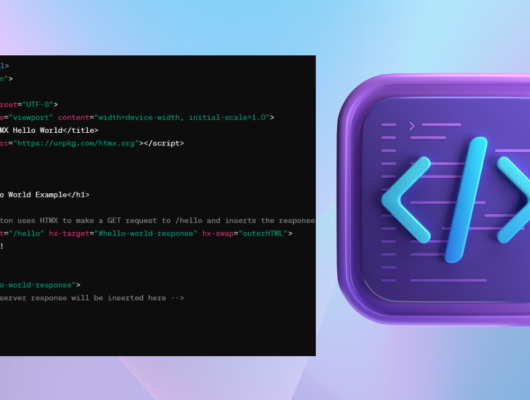Next.js is a sophisticated framework in web and mobile application development that is highly efficient and user-friendly. Next.js, created by Vercel, expands the capabilities of React.js by offering a range of features aimed at improving productivity and performance. This blog delves into the transformative influence of Next.js on web development and its possible implications for mobile app development.
Enhancing Web Development with Next.js
Server-Side Rendering (SSR) for SEO and Performance
Next.js excels in providing effortless Server-Side Rendering (SSR), benefiting SEO and reducing initial page load times. Server-Side Rendering (SSR) involves rendering React components on the server and sending completely rendered pages to the browser. This method greatly helps SEO by making sure content can be indexed by search engines and improves user experience by decreasing the time it takes for the first meaningful paint to appear.
Static Site Generation (SSG) for Speed and Scalability
Next.js also facilitates Static Site Generation (SSG), enabling developers to pre-render pages during the construction process. This is especially beneficial for websites with static pages, as it allows for quick page loading and decreased server strain, resulting in more efficient scalability during periods of heavy traffic.
Incremental Static Regeneration (ISR) for Dynamic Content
Incremental Static Regeneration (ISR) combines static and dynamic content production. ISR allows developers to modify static content post-deployment without the need to rebuild the entire site, providing a dynamic user experience while retaining the performance advantages of static generation.
Built-in Image Optimization
Next.js’s Image component optimises images for faster loading by providing them in contemporary formats like WebP and scaling them according to the user’s device. This functionality is crucial for enhancing the efficiency and user experience of web and mobile applications.
To be a good JavaScript developer, embrace the principles of learning continuously, coding purposefully, and innovating tirelessly. With tools like Next.js, the path to building exceptional web and mobile experiences is not just a possibility but a reality.
Next.js in Mobile Application Development
Next.js is mainly used for web development but can also be advantageous for mobile app development, particularly when combined with frameworks such as React Native or through Progressive Web Apps (PWAs).
Common logic and components
Developers may streamline their development process and minimise the maintenance of different codebases by sharing functionality and components between their Next.js online applications and React Native mobile applications.
Progressive Web Apps
Next.js is a superb option for developing Progressive Web Apps (PWAs). PWAs utilise contemporary web features to provide users with an application-like interface. Next.js simplifies the development of PWAs that are quick, interactive, and dependable with its integration of service workers, web app manifests, and seamless HTTPS compatibility.
Enhancing Mobile Web Experience
Next.js’ performance optimisation capabilities, like SSR, SSG, and image optimisation, improve load speeds and data efficiency for mobile users. It is essential for maintaining consumers who use web apps on mobile devices, as network circumstances may vary.
Conclusion
Next.js is redefining the paradigms of web and mobile application development. The extensive range of features it offers caters to the essential requirements of contemporary applications: speed, search engine optimisation, and user satisfaction. Next.js enhances React by incorporating server-side functionalities, image optimisation, and other features, allowing developers to create high-performance, scalable applications that work seamlessly on several platforms.
In the future, Next.js is expected to play an increasingly important role in both online and mobile development. Next.js is a reliable framework for developing advanced web and mobile applications due to its efficient development processes, continuous improvements, and strong community support.
Frequently Asked Questions (FAQs)
- What is Next.js and why is it important for web development?
Next.js is an open-source React front-end development web framework that enables functionalities such as server-side rendering and static site generation, making it easier to build fast, scalable, and SEO-friendly web applications.
- Can Next.js be used for mobile application development?
While Next.js is primarily designed for web development, its components and logic can be shared with mobile applications developed with React Native. Additionally, Next.js can be used to create Progressive Web Apps (PWAs), which offer a mobile app-like experience.
- How does Next.js improve SEO?
Next.js improves SEO through server-side rendering (SSR), which ensures that search engines can crawl and index the content of web pages more effectively. This is crucial for achieving higher rankings in search results.
- What makes Next.js suitable for building PWAs?
Next.js supports features crucial for PWAs, such as service workers, web app manifests, and HTTPS, enabling developers to build web applications that load quickly, work offline, and are engaging.
- How does Next.js handle image optimization?
Next.js provides the Image component, which automatically optimizes images for faster load times by resizing, compressing, and converting images to more efficient formats like WebP based on the user’s device and browser.
- Can Next.js applications be deployed on any server?
Next.js applications can be deployed on a variety of hosting platforms that support Node.js. Vercel, the company behind Next.js, offers a seamless deployment experience, but developers can also use other cloud providers like AWS, Google Cloud, and more.






